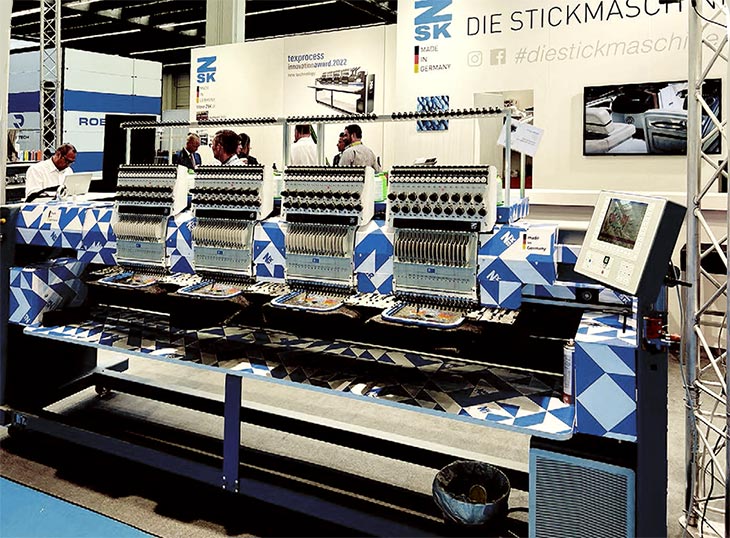The following article comes with the kind permission of the trade journal for textile finishing and promotion TVP - October 2022
Up to 2,000 stitches/minute with multi-head embroidery machines
"ZSK R-Stickkopf" with unique 1st and 2nd order mass balance is awarded the "Texprocess Innovation Award".
(TVP/AF) For owners of industrial embroidery machines, embroidery accuracy and safe operation with few thread breaks and skipped stitches are important factors. The machines should also run as quietly as possible and without vibrations.
The embroidery machine manufacturer ZSK STICKMASCHINEN has developed a new type of embroidery head for single and multi-head embroidery machines especially for these requirements. The project was presented to the public for the first time at the Texprocess in Frankfurt and received the "Texprocess Innovation Award".

According to ZSK, the new "R-head" should reach embroidery speeds of up to 2,000 stitches per minute. Traditional multi-head embroidery machines currently reach embroidery speeds of up to a maximum of 1,200 stitches per minute.
With the innovation, ZSK wants to enable a new dimension of productivity with higher embroidery precision and reliability, even at high embroidery speeds.
According to ZSK, the noise emissions can be significantly reduced with the R head compared to current embroidery heads. Customers should also be able to replace it themselves if necessary.
Photo: Andreas Farnung / TVP 05/2022

More about the project: The built-in embroidery heads have a major influence on pattern precision, embroidery safety and smooth running.
The reason for this is that considerable mass forces can occur in the embroidery heads, which are transferred from the embroidery heads to the machine frame and cause it to vibrate.
Especially with multi-head embroidery machines, where the embroidery heads are arranged next to each other on the upper traverse, the sum is so large that the upper traverse is set in torsional vibrations relative to its longitudinal axis (see graphic).
Due to these torsional vibrations, the embroidery heads attached to the upper traverse perform slight pitching movements, causing the needles to move horizontally. These horizontal movements of the needles relative to the needle plates then cause imprecise embroidery patterns.
The horizontal movements of the needles also lead to fluctuating distances between the hook points and the grooves of the needles. Since a secure loop catch requires a very precise distance between the hook tip and the scarf, the fluctuating distances lead to reduced embroidery safety with thread breaks or skipped stitches. In addition, the machine frame vibrations generated by the mass forces of the embroidery heads cause unfavorable noise emissions.
The mass forces in the embroidery heads are mainly caused by the needle bar drive and the oscillating vertical movements of the needle bars and presser feet. The magnitude of the inertial forces is strongly dependent on the machine speed, since the inertial forces in the embroidery head increase quadratically with increasing embroidery speed. For example, the mass forces are four times higher at an embroidery speed of 1,200 stitches/minute than at 600 stitches/minute. All efforts to date to reduce the mass forces occurring in the embroidery head have not yet led to a significant reduction, reports ZSK.

Inertial forces are reduced by a balancing mechanism
The aim of the new ZSK project was therefore to develop an embroidery head mechanism that transfers significantly lower mass forces to the machine frame. At the same time, the embroidery head mechanics should be improved so that they can be operated safely under 24/7 production conditions at embroidery speeds of 2,000 stitches/minute.
These ambitious goals were achieved with the newly developed "R-stick head" by integrating an innovative mass balancing mechanism that significantly reduces the first and second order inertial forces.
"This is comparable to the smooth running of a multi-cylinder internal combustion engine with the unfavorable smooth running of a 1-cylinder," explains ZSK.
Photo: Representatives of ZSK at the presentation of the "Texprocess Innovation Awards" (Photo: Messe Frankfurt Exhibition GmbH/Thomas Fedra)

In the ZSK graphic "Diagram of mass forces to embroidery speed" the mass forces occurring with a conventionally designed embroidery head are compared with the mass forces occurring with the "R embroidery head".
The diagram first shows the above-mentioned quadratic dependence of the mass forces on the embroidery speed (e.g. the mass forces at 1,200 stitches/minute are four times as high as at 600 stitches/minute). On the other hand, it becomes clear how the mass forces could be reduced with the new "R-stick head".
For example, at 2,000 stitches/minute, the mass forces are lower than with a conventional head that is operated at 600 stitches/minute. The innovative "R embroidery heads" are installed in the new machines of the "ZSK R-Series".
